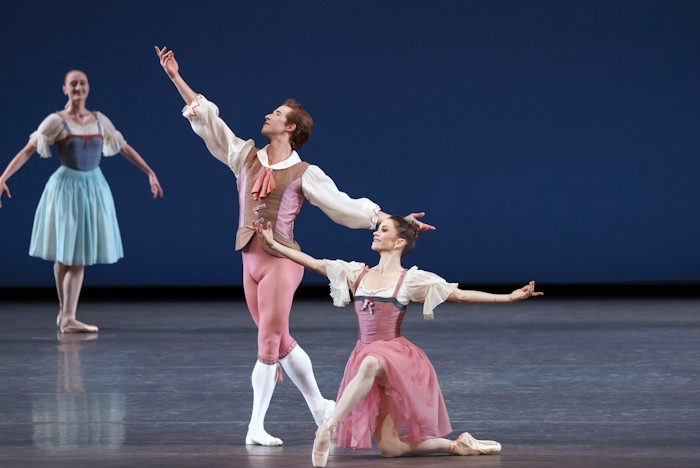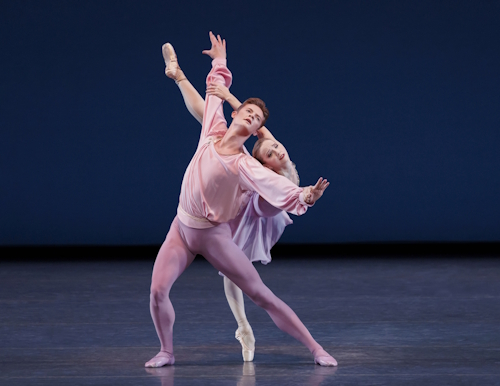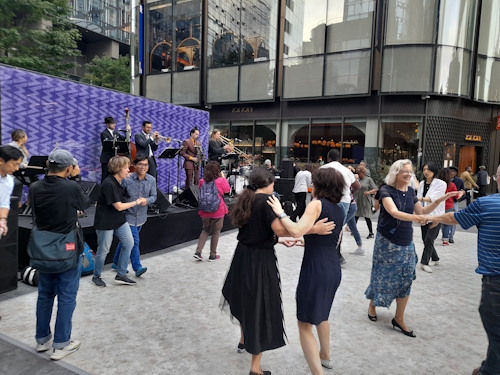David H. Koch Theater, New York City
September 23, 2025
This first of the two all-Balanchine programmes this season at New York City Ballet proved a pleasing, if unexciting evening. While nicely danced as always, it would be fair to say that none of the three ballets are out of the company founder’s top drawer.
Donizetti Variations is an intimate ballet that’s helped along enormously by the music, taken from the composer’s opera, Don Sebastien. Light and easy on the eye, the choreography is a mix of lovely ensemble work and more virtuoso steps for the ballets two leads, Megan Fairchild and Anthony Huxley, and the corps of two trios of a man and two women.
The buoyant corps really were very good indeed, dancing with freedom and effervescence. They breezed through everything with ease, and looked like they were enjoying themselves too, although there were a few arms out of sync here and there. Unusually, the corps’ best moments, certainly the best togetherness, came from the three men (Kennard Henson, Charlie Klesa and Mckenzie Bernardino Soares).
At the ballet’s centre, Fairchild was assured and confident as she ate up the space. Huxley was elegant and commanding, with his allegro particularly catching the eye. Together, they gave a masterful display.
Returning to the repertory after a gap of 22 years, the more lyrical Ballade, to Gabriel Fauré’s Ballade for piano and orchestra, Op.19, is a series of pas de deux and solos for a ballerina, her cavalier and a corps of ten women. It may only be 14 minutes long, but Balanchine packs quite a lot in.
The tone is set from the off when the ballerina, Emma von Enck, wafts in on pointe from an upstage wing like some sort of dreamy apparition. She’s a beautiful dancer, refined and precise. It’s easy to see why she’s become such a New York audience favourite. Together with Jules Mabie, she gave the ballet a generous helping of youthful doe-eyed romanticism.
When Balanchine meets Tchaikovsky the result is usually something special. Not so with his attempt at Swan Lake, which draws from the lakeside scenes of the usual Acts Two and Four.
Perhaps it’s the disassociation from the rest of the story, but the performance was strangely devoid of emotion. As Odette, Isabella LaFreniere (replacing Sara Mearns), usually so reliable, seemed cool and detached. Everything in Swan Lake has meaning, every step, every look, every gesture. Yet here, while everything was there, very little seemed to have meaning behind it. Her Siegfried, Tyler Angle, was a supportive partner, but any depth of connection was difficult to discern.
Elsewhere, the corps was a little scratchy, lines and arms not as straight as they should have been. An oddity, is that Siegfried’s hunting party stand with the swans during the pas de deux; those same swans (who now seem content for them to be there) that they were going to put an arrow through ten minutes earlier.
It says something that the most interesting thing about the piece are the designs. Alain Vaës’ icy lakeside cavern is a real picture. The fact that he chose to costume the other swans in black will come as a surprise to some, but he was not the first to do so, and far from the last. I rather like the idea. It certainly makes Odette stand out, suggests her status and being is different, and lends a strong connection to Odile in Act Three. Except that here, we do not have an Odile or Act Three.
Elsewhere, Rothbart’s costume is wonderful. So, what a shame it’s not put to better use. All he gets to do is walk on and flap his arms up and down slowly and rather mechanically, then walk off again. Scary? I think not. You had to feel for Samuel Melnikov, you really did.
Works & Process
It was interesting to see the Donizetti Variations pas de deux in full performance having been at a Works & Process evening when it was presented by Dance Theatre of Harlem’s Kamala Saara and Kouadio Davis, after which NYCB artistic director Jonathan Stafford gave some coaching tips.
That evening, The Art of the Duet, featured other DTH dancers in pas de deux from artistic director Robert Garland’s New Bach, John Taras’ Firebird, with an ensemble section from Garland’s Higher Ground to round things off. In between, Garland and original Firebird cast member Donald Williams chatted and joked amiably. It was a joy to listen to them.
Dance Theatre of Harlem: Art of the Duet was one of numerous evenings that aim to take audiences behind the scenes, held at the Peter B. Lewis Theater at the Guggenheim Museum. I also enjoyed an hour with tap choreographer Ayodele Casel, the culmination of a Works & Process residency at Kaatsbaan Cultural Park; and with Wendy Whelan and Jamar Roberts who talked about the latter’s forthcoming NYCB premiere, with a few preview moments danced along the way. A feature of the evenings is that conversation can be continued over a glass of wine in the Guggenheim’s rotunda; and in the case of DTH’s event, the chance to dance too.
But Works & Process is about more than theatre presentations. The season is also about participation, especially in four early evenings outdoors at Manhattan West. A swing evening with Gaby Cook and the Eyal Vilner Big Band included learning some basics, the chance to dance in a sort of jam, performance, and some fabulous live music. It was great fun, even with a bit of a chill breeze blowing.
Works & Process also produces aver 25 creative residences annually with a network of around a dozen partners in New York and surrounding states. These provide much needed support and space for development for artists and come with 24/7 studio access, on-sit accommodation, health insurance, artist fees and a transportation stipend. It really is an amazing and very worthwhile programme.





